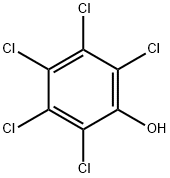Pentachlorophenol suppliers
Pentachlorophenol
- CAS:
- 87-86-5
- MF:
- C6HCl5O
- MW:
- 266.34
Properties
- Melting point:
- 165-180 °C(lit.)
- Boiling point:
- 310 °C(lit.)
- Density
- 1.978 g/mL at 25 °C(lit.)
- vapor density
- 9.2 (vs air)
- vapor pressure
- 40 mm Hg ( 211.2 °C)
- refractive index
- 1.6310 (estimate)
- Flash point:
- 11 °C
- storage temp.
- 0-6°C
- solubility
- Chloroform (Slightly), Ethyl Acetate (Sparingly)
- form
- Liquid
- pka
- 4.80 (Blackman et al., 1955)
5.3 (Eder and Weber, 1980)
- Water Solubility
- 80 mg l-1(30 °C)
- Specific Gravity
- 1.979
- Merck
- 7109
- BRN
- 1285380
- Henry's Law Constant
- 21 (quoted, Petrasek et al., 1983)
- Exposure limits
- NIOSH REL: IDLH 0.5 mg/m3, IDLH 2.5 mg/m3; OSHA PEL: TWA 0.5 mg/m3; ACGIH TLV: TWA 0.5 mg/m3
- Stability:
- Stable. Incompatible with strong oxidizing agents.
Safety Information
- Symbol(GHS)



GHS06,GHS08,GHS09
- Signal word
- Danger
- Hazard statements
- H301+H311-H315-H319-H330-H335-H351-H410
- Precautionary statements
- P202-P273-P280-P302+P352+P312-P304+P340+P310-P305+P351+P338
- Hazard Codes
- T+,N,T,F,Xn
- Risk Statements
- 24/25-26-36/37/38-40-50/53-39/23/24/25-23/24/25-11-52/53-51/53
- Safety Statements
- 22-36/37-45-52-60-61-16-7
- RIDADR
- UN 3155 6.1/PG 2
- WGK Germany
- 3
- RTECS
- SM6300000
- HazardClass
- 6.1(a)
- PackingGroup
- II
- HS Code
- 29081100
- Toxicity
- Pentachlorophenol (PCP) is very toxic to plants and are used as preharvest defoliants and general herbicides. Their use as herbicides is currently restricted to nonagricultural uses along drainage ditches, driveways, and fencerows.
Commercial (technical) grades of PCP commonly contain manufacturing by- products, such as dioxin (HxCDD), which can be more toxic than the PCP itself. Another contaminant in PCP is HCB (Hexachlorobenzene). The use of PCP is being phased out because of the discovery of these highly toxic contaminants (9). PCP is a Restricted Use Pesticide (RUP). Restricted Use Pesticides may be purchased and used only by certified applicators.
In 1988 the EPA announced further restrictions on the use of PCP as in the pulp and paper industry where it is used in paper coatings, sizing, adhesives and in inks. Registration for use in cooling towers and for certain oil well operations was also cancelled. The 1988 regulations also required compliance with dioxin (HxCDD) concentration limits in the final product.
- IDLA
- 2.5 mg/m3
Use
Pentachlorophenol (PCP) is an odourless, white or light brown powder or crystal in appearance. It is used as herbicide and fungicide. Pentachlorophenol is incompatible with strong oxidising agents. Pentachlorophenol has a very sharp characteristic phenolic smell when hot but very little odour at room temperature. Pentachlorophenol is a synthetic substance made from other chemicals and does not occur naturally in the environment. Initially pentachlorophenol was widely used as a wood preservative. It is now used industrially as a wood preservative for power line poles, cross arms, fence post, etc. Used as insecticide for terminate control; pre-harvest defoliant; general herbicide. Antimicrobial preservative and fungicide for wood, wood products, starches, textiles, paints, adhesives, leather, pulp, paper, industrial waste systems, building materials. Surface disinfectant.
According to relevant laws, regulations, policies and the provisions of this website, this website does not display the product information!
The source is "剧毒、有毒、易致癌化学品". If the information is inaccurate, please contact the platform to modify it.
contact information:info@chemicalbook.com 400-158-660


